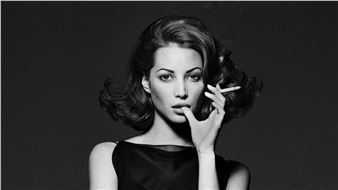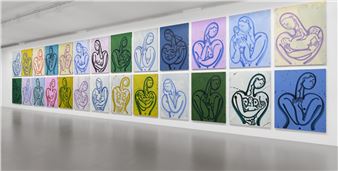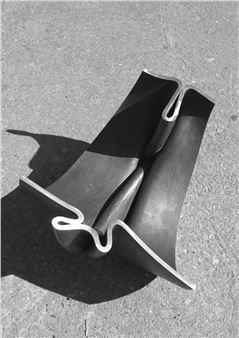Der Goldene Reiter
Nobody has revolutionized German post-war cinema quite like Rainer Werner Fassbinder (1945‚Äď1982). The radical artistic aspirations he pursued during his short but fruitful career live on up to this day and serve as a driving force behind the group exhibition Der Goldene Reiter in Faustrecht der Freiheit aka Fox and His Friends. Bringing together various contemporary positions, the impulse of this exhibition is, rather than to provide an overview of his life and work, to shed new light on his long-lasting artistic authority, his aesthetic innovation and subversive politics.
The exhibition borrows its title from RWF’s film Fox and His Friends (1975) as a tribute to his complex legacy on the occasion of what would have been his 75th birthday and stages a dialogue with contemporary artworks through associations and atmospheric connections to both his creative output, as well as what was his cultural and political present. Franz Bieberkopf aka Fox, the film's main character, is a working-class antihero, a sucker for love and a classic Fassbinder type of loser who falls victim to his own romanticism. Having won the lottery, his feelings and means are exploited, and he is quickly left with nothing. The moving, the tragic and the melodramatic are a crucial part of Fassbinder’s aesthetic concept, which oscillates between the private and the political, the intimate and the social, the bizarre and the mundane, and is devoted to the fragility and exploitability of human emotions and the failure of human relationships under changing social circumstances.
The direct, pithy style of his films is mimicked in the form of an exhibition which provides a cross section of independent segments that each contain an impression, a perception or a thought associated with RWF’s anticipatory poetics. From more obvious references such as the portrait by Wolfgang Tillmans of one of Fassbinder’s favorite actresses Irm Hermann, through the subjective reinterpretation of public toilets as cruising hotspots in Raphaela Vogel’s Uterusland (2018), to an erotic display of pleasure in Patrick More (2013) by Sarah Lucas, this exhibition with its mosaic-like narrative is conceived as a stream of consciousness, a journey from fragment to fragment with regard to RWF’s radical aesthetic merging of sexuality, politics and biography.
A highly polarizing figure, Fassbinder‚Äôs cigarette, drug and alcohol abuse as well as his standing as a radical outsider to a bourgeois society reify the myth of the artist as ‚Äúthe ingenious monster‚ÄĚ. This clich√© of the solitary genius is mirrored through imagery of great artists ranging from Auguste Rodin and Paul Gauguin, to RWF‚Äôs contemporary Joseph Beuys and controversial personalities such as Jonathan Meese, presented as uncompromising figures.
Just as Brinkmann’s poem cited above is a collage of moments that reflect the heterogeneity of our perception, read not as a consistently developed narrative but as a hopping from snippet to snippet, so is the current group exhibition a subjective cross section of temporally and intuitively related artistic and pop-cultural fragments. This selection of works is as much an homage to RWF as it is a love song to artistic practice as a whole, marking the limits of understanding human nature and emotions and their possibilities for expression.

Recommended for you
Nobody has revolutionized German post-war cinema quite like Rainer Werner Fassbinder (1945‚Äď1982). The radical artistic aspirations he pursued during his short but fruitful career live on up to this day and serve as a driving force behind the group exhibition Der Goldene Reiter in Faustrecht der Freiheit aka Fox and His Friends. Bringing together various contemporary positions, the impulse of this exhibition is, rather than to provide an overview of his life and work, to shed new light on his long-lasting artistic authority, his aesthetic innovation and subversive politics.
The exhibition borrows its title from RWF’s film Fox and His Friends (1975) as a tribute to his complex legacy on the occasion of what would have been his 75th birthday and stages a dialogue with contemporary artworks through associations and atmospheric connections to both his creative output, as well as what was his cultural and political present. Franz Bieberkopf aka Fox, the film's main character, is a working-class antihero, a sucker for love and a classic Fassbinder type of loser who falls victim to his own romanticism. Having won the lottery, his feelings and means are exploited, and he is quickly left with nothing. The moving, the tragic and the melodramatic are a crucial part of Fassbinder’s aesthetic concept, which oscillates between the private and the political, the intimate and the social, the bizarre and the mundane, and is devoted to the fragility and exploitability of human emotions and the failure of human relationships under changing social circumstances.
The direct, pithy style of his films is mimicked in the form of an exhibition which provides a cross section of independent segments that each contain an impression, a perception or a thought associated with RWF’s anticipatory poetics. From more obvious references such as the portrait by Wolfgang Tillmans of one of Fassbinder’s favorite actresses Irm Hermann, through the subjective reinterpretation of public toilets as cruising hotspots in Raphaela Vogel’s Uterusland (2018), to an erotic display of pleasure in Patrick More (2013) by Sarah Lucas, this exhibition with its mosaic-like narrative is conceived as a stream of consciousness, a journey from fragment to fragment with regard to RWF’s radical aesthetic merging of sexuality, politics and biography.
A highly polarizing figure, Fassbinder‚Äôs cigarette, drug and alcohol abuse as well as his standing as a radical outsider to a bourgeois society reify the myth of the artist as ‚Äúthe ingenious monster‚ÄĚ. This clich√© of the solitary genius is mirrored through imagery of great artists ranging from Auguste Rodin and Paul Gauguin, to RWF‚Äôs contemporary Joseph Beuys and controversial personalities such as Jonathan Meese, presented as uncompromising figures.
Just as Brinkmann’s poem cited above is a collage of moments that reflect the heterogeneity of our perception, read not as a consistently developed narrative but as a hopping from snippet to snippet, so is the current group exhibition a subjective cross section of temporally and intuitively related artistic and pop-cultural fragments. This selection of works is as much an homage to RWF as it is a love song to artistic practice as a whole, marking the limits of understanding human nature and emotions and their possibilities for expression.
Contact details


 ARTISTS
ARTISTS














